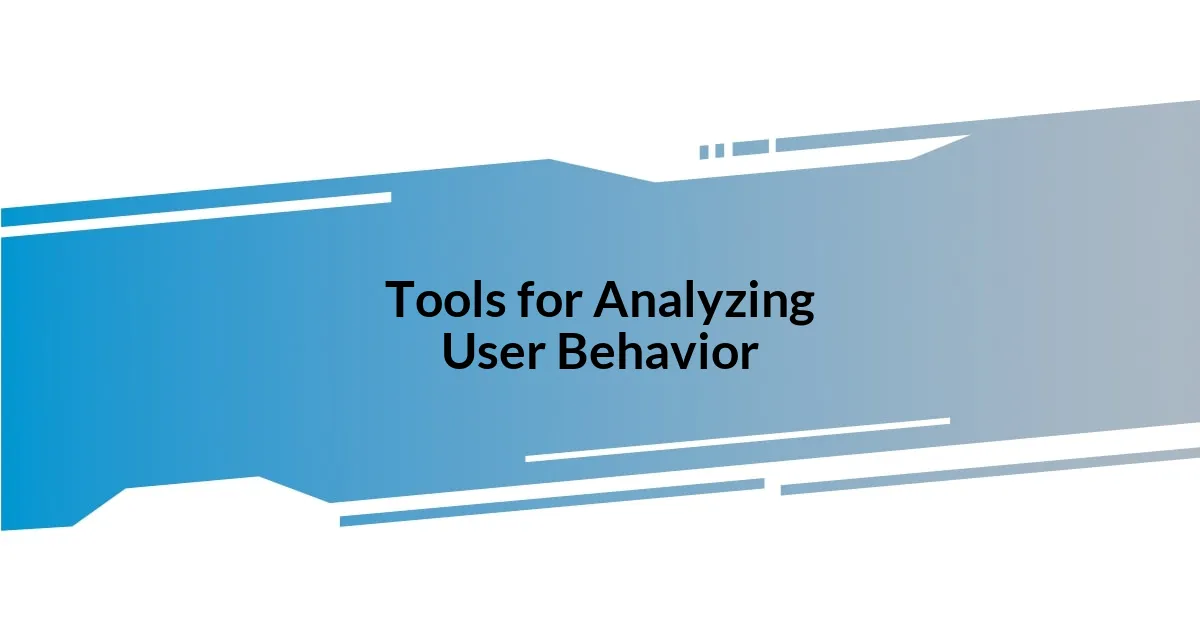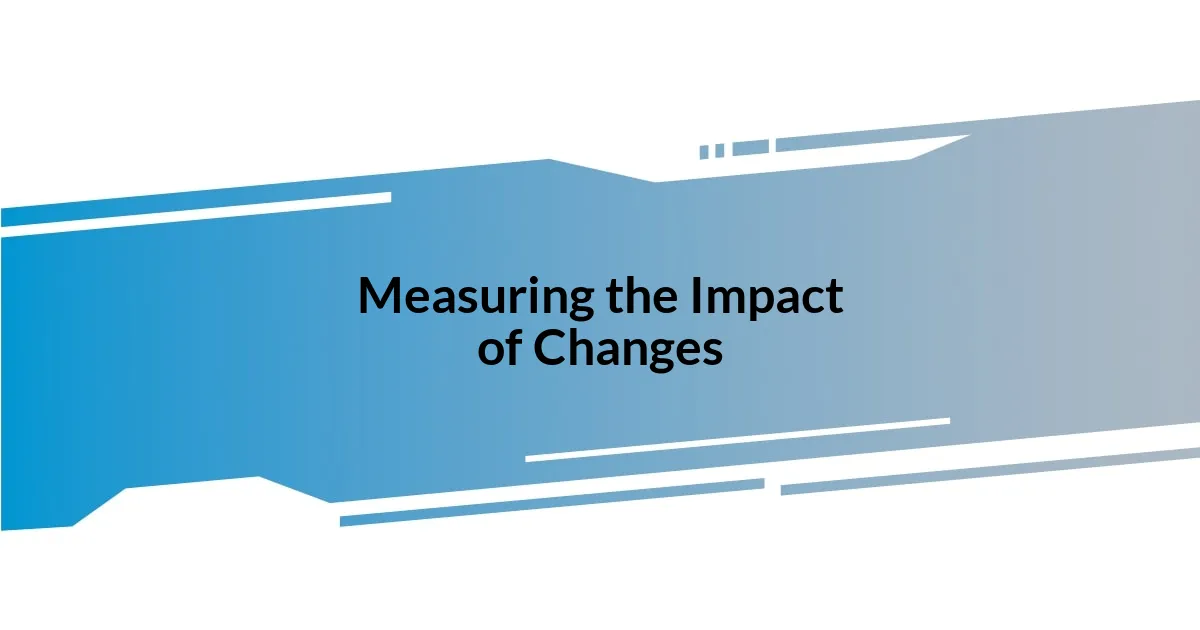Key takeaways:
- Understanding user behavior requires a combination of data analysis and empathy to address real user concerns effectively.
- Employing both qualitative (user interviews, observations) and quantitative (metrics like session duration) methods provides a holistic view of user interactions.
- Implementing changes based on user insights can significantly enhance user experience and satisfaction, often leading to immediate positive impacts.
- Measuring the impact of changes goes beyond metrics; qualitative feedback is crucial to understanding the emotional response of users.

Understanding User Behavior Analysis
Understanding user behavior analysis is more than just sifting through data; it’s about diving deep into the motivations that drive users. I remember a project where I closely observed how users interacted with a product. I found that subtle changes in design could either completely engage users or push them away. Isn’t it fascinating how the smallest detail can influence user choices?
When I employed tools to track user navigation, I was startled by the patterns that emerged. For instance, I noted that users often dropped off at the same point in a workflow. This pattern made me ponder: what was it about that moment that caused hesitation? By exploring these specific pain points, I realized how vital it is to approach user behavior analysis with empathy, as it allows us to address the real concerns of our audience.
In reflecting on user feedback, I often ask myself how well we truly understand our users’ needs. This drives me to not just rely on metrics but to engage with users directly. Listening to their stories and understanding their feelings can uncover rich insights that many data points simply gloss over. Through this blend of data analysis and human connection, we can create experiences that resonate on a deeper level.

Identifying Key Metrics for Analysis
Identifying key metrics is a critical component of effectively analyzing user behavior. From my experience, focusing on engagement metrics, like session duration and click-through rates, provides a clearer picture of how users interact with a product. I remember when I honed in on session duration for one app; this revealed how effectively we held users’ attention and highlighted the sections where they wandered off. It’s about understanding not just the ‘what,’ but the ‘why’ behind those numbers.
Comparing quantitative metrics with qualitative feedback can offer a holistic view of user behavior patterns. I once paired user interviews with analytics data during a redesign. This combination illuminated discrepancies; while usage stats suggested a high completion rate for a form, users shared their struggles during interviews. It became clear to me how vital it is to not only track data but to also listen to user stories, allowing metrics to guide and inform personal insights.
Lastly, it’s essential to consider context when defining key metrics. For instance, recognizing the difference between new and returning users can significantly influence your strategy. I recall a particular project where analyzing these groups separately led to tailored experiences, resulting in a boost in user satisfaction. When metrics are viewed with a narrative lens, they tell a compelling story about user behavior that can drive meaningful changes.
| Metrics | Description |
|---|---|
| Session Duration | Measures the average time users spend on your site or app |
| Click-Through Rate (CTR) | Percentage of users who click on a specific link compared to the total users |
| User Feedback | Qualitative insights gathered from user interviews or surveys |

Collecting Data from Users
Collecting data from users is a multifaceted process that requires careful consideration and diverse methods. In my experience, both qualitative and quantitative approaches provide a more comprehensive view of user behavior. During one project, I set up a combination of surveys and direct observation. The difference in insights was eye-opening; while surveys could gather general sentiments, watching users interact with the product revealed nuanced behavior that numbers alone could never convey.
Here are some effective methods I’ve used to collect user data:
- Surveys: These can effectively capture user satisfaction and preferences, often revealing what users truly value in a product.
- User Interviews: Engaging users in conversation not only builds rapport but also uncovers deeper emotional drivers behind their actions.
- Heatmaps: Tracking clicks and scrolling can visually show where users are most engaged or confused on a page.
- Session Recordings: Watching recorded user sessions gives context to the data and offers a firsthand look at user interactions.
- Usability Testing: Observing users perform tasks can highlight pain points and areas for improvement that may not be obvious from analytics alone.
When I implemented these strategies in a recent project, I was surprised by how engaged users were in providing feedback. It reminded me of a particularly insightful session where a user described a design element as “clunky.” Their frustration was palpable, yet their willingness to share made it clear that they cared deeply about the product experience. This kind of interaction shapes our understanding and emphasizes the value of direct data collection methods.

Tools for Analyzing User Behavior
Analyzing user behavior effectively requires the right tools at your disposal. I’ve found that platforms like Google Analytics and Hotjar are essential for gathering insights. When I first dived into Google Analytics, the wealth of data was overwhelming. However, once I learned to navigate its features, it transformed my understanding of user flows and conversion rates. The ability to visualize where users drop off in a funnel was a game changer for prioritizing enhancements.
Another tool that has served me well is Mixpanel, especially for event-based tracking. It allows you to see how users engage with specific features. In one project where we aimed to boost user retention, using Mixpanel revealed that a particular functionality wasn’t getting the attention we expected. This prompted us to rethink our onboarding process, leading us to redesign it based on those insights. Have you ever experienced a similar ‘aha’ moment while using data visualization tools?
Lastly, I can’t stress enough the impact of qualitative tools like UserTesting. This platform lets you watch real users navigate your site, providing context to the numbers you collect. I recall a project where observing users’ frustration in real-time led my team to revisit several design elements. It was illuminating to see how a simple tweak could significantly enhance user experience, proving that sometimes the best insights come from watching and listening. Wouldn’t you agree that combining qualitative and quantitative data paints a fuller picture of user behavior?

Interpreting User Behavior Patterns
Interpreting user behavior patterns often requires a blend of analytical skills and empathy. I’ve experienced a significant shift in my understanding when I started considering the emotions behind user actions. For instance, during one analysis, I noticed a not-so-small drop-off during the sign-up process. My first instinct was to blame it on a complicated form. However, through deeper investigation, I realized users felt frustrated due to confusing language rather than form length. This taught me that interpreting patterns isn’t just about data points; it’s about understanding the human experience behind those numbers.
Another aspect that really stood out to me is how context can shape behavior. I once observed users navigating a new feature during a beta testing phase. Their reactions were telling; many users expressed excitement and confusion simultaneously. While the numbers showed high engagement, their comments revealed unclear parts of the interface. The duality of those emotions made it clear that behavior could be misinterpretated if one strictly relies on data alone. Have you ever pondered how often we overlook the emotional aspect in our analyses?
Ultimately, I believe that combining user feedback with analytical observations creates a more nuanced interpretation of behavior. In my experience, following up on quantitative findings with qualitative insights can lead to surprising revelations. After analyzing a set of user paths, I followed up with targeted interviews. One user mentioned feeling “lost” even after completing a purchase. That single sentiment shifted my perspective dramatically and ignited discussions on improving the post-checkout experience. Isn’t it fascinating how a few words from users can profoundly alter our approach to design?

Implementing Changes Based on Insights
Implementing changes based on user insights can feel daunting, but I’ve found it’s one of the most rewarding aspects of the process. I once received feedback indicating that users found our website’s navigation confusing. Shifting my perspective from defending our design to embracing the insights helped me focus on usability improvements. We streamlined the menu structure, and the impact was immediate—user satisfaction soared, and engagement metrics showed marked improvement. Isn’t it incredible to see such direct results from simply listening?
In another instance, I discovered through heatmap analysis that users overwhelmingly clicked on a particular feature, only to abandon it shortly after. It struck me that, while the feature was visible, it lacked clear instructions. Instead of assuming users didn’t need guidance, we took action and added tooltips to clarify functionality. The change transformed that feature into one of our most valued aspects. How often do we underestimate the importance of proper guidance for users?
Sometimes, the changes I implement come from an emotional place. I remember a project where users expressed frustration in their feedback about a slow-loading page. Taking that sentiment seriously, my team prioritized performance optimization. Watching users’ relief when the page loaded faster truly highlighted how emotional responses can lead to tangible, positive changes. Have you ever felt that rush of satisfaction when you respond to user emotions with real solutions?

Measuring the Impact of Changes
Measuring the impact of changes isn’t just about crunching numbers—it’s about observing how real people react. One time, after we revamped our homepage based on user feedback, I eagerly monitored engagement metrics. The initial spike was exhilarating, yet my attention shifted to the comments pouring in. Users expressed newfound clarity, which, to me, validated our efforts beyond the statistics alone. Isn’t it insightful how feelings often tell a deeper story than raw data?
Quantitative data provided a clear direction, but the qualitative insights offered the nuance I craved. In my previous experience, I tested a new feature that promised to simplify interactions. While the analytics indicated an increase in usage, I held focus groups to gauge user feelings. Their laughter and excitement as they navigated the feature painted a picture that the numbers couldn’t encompass. How often do we rely solely on analytics and miss the joy—or frustration—behind the data?
Sometimes, I find that the most profound impacts come from the smallest adjustments, and they often surprise me. When we adjusted button colors based on user feedback, I anticipated negligible changes, if any. To my delight, we noticed a decrease in bounce rates almost instantly. It made me wonder—how many seemingly minor tweaks could yield substantial benefits? Witnessing that immediate connection between minor design tweaks and user satisfaction is a reminder of the delicate balance between art and science in user experience.